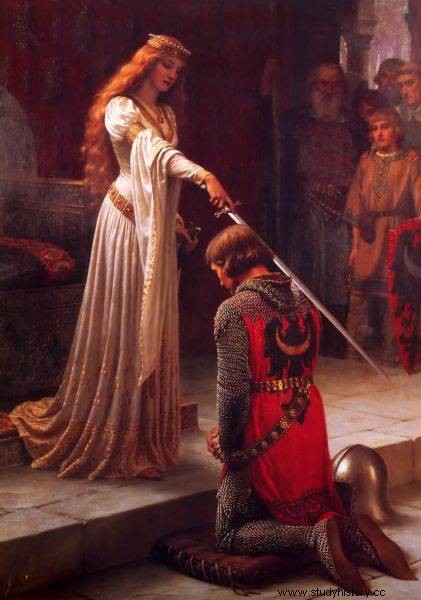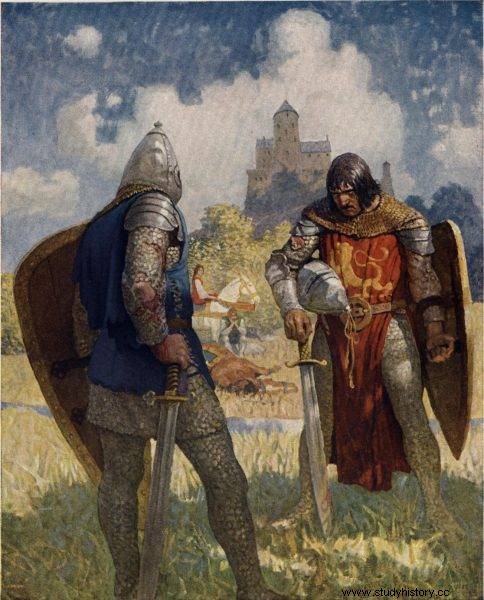Rough boor and brutal, romantic, warrior, or maybe a politician and advisor? What did it mean to belong to the caste of knights and how did they really stand out from the society?
The archetype of a knight evokes very unambiguous associations:a man in armor riding a horse, wielding a sword or a lance, eternally entangled in romances, wars or wandering in search of some equivalent of the Holy Grail. But does such a "book" picture result from historical facts, or is it an exaggerated version of the truth straight from legends?
To judge this, you will need to take a closer look at the knights - and that means a quick overview of nearly eight centuries of European history! As Frances Gies writes:
Though changes have happened constantly, in practice the long history of knights can be divided into three stages:the first was the appearance of an armed, mounted soldier in the confused 11th and 10th centuries; in the second phase there was the formation of a "mature" institution of knighthood, which took place in the period from the 11th to the 13th century , that is, during the lifetime of the creators of the legends about King Arthur; and finally, in the third stage, there was the decline and fall of this institution as a result of the development of new social forces at the end of the Middle Ages and at the beginning of the early modern period.
Knight - Brute
At first, the knights in no way resembled the idealized version of Arthurian legends. "This image has the disadvantage of being static, somewhat rigid and artificial, and it reflects a concept more closely related to legends and literature than to real life," says Frances Gies in The Life of a Medieval Knight.
It all starts with people who we would never call "chivalrous", on the contrary: they were violent warriors who were willing to use their power advantage for private ends. They did not yet have a set of rules, ethos, or "virtues." Rough and self-confident, they aroused more fear than respect. Their equipment was the main feature of the rest of the society. They had, to say the least, expensive and high-quality equipment in the form of a horse, armor and weapons.

At first, the knights in no way resembled the idealized version of Arthurian legend.
In the tenth century, the warrior caste was often problematic, so there was a need to subordinate them to some form of rule. Here the Church turned out to be the perfect ally of order. The clergy finally managed to instill in the knights a need to belong and a fear of the consequences of their actions - if not in life, then judged by the Creator.
Of course, membership in the elite "club" of the Lord's warriors was not free:the armed repaid the Church with loyalty, and therefore most often with protection. Eventually it came to the point that " belonging to the knighthood meant a unique kind of prestige, and knighting was considered an honor , valued by the powerful and aristocrats, and even by members of royal families ", writes Frances Gies.
Until then, the sword and spurs were treated as insignia of chivalry. The armor at that time consisted of only chain mail and a helmet, as well as an oblong shield
Knight - God's fighter
When Pope Urban II announced the first crusade in 1095, knights from all over Europe followed his call. For the armed warriors it was also an opportunity to gain land and property, so they willingly took part in the project. They gathered under the banner of the magnates and marched to Constantinople, from where they would later attack the Saracens.
By this time, the influence of the Church on the knightly caste was already very clear. Frances Gies writes:
Soon after 1070, French sources first mentioned ceremonial investiture, known as "knighting," which was usually done in churches. With this initiation ritual, the Church officially recognized the knighthood, as it had previously taken over many other secular institutions like pagan festivals and shrines.

The text was created, among others based on the book by Frances Gies "Życie medieval knight", which has just been released by the Znak Horyzont publishing house.
At the same time, the title of knight became much more prestigious - so much so that it was readily accepted by members of the higher social classes. What's more, the knighthood began to be associated with those higher than itself, which made it gain in value. From the rural huts, the armed men began to gradually move to castles, and the gentlemen willingly used their experience and knowledge.
Find out more:Unbeatable patterns or cruelty killing for money? Who were the medieval knights really?
Knight from tales
Finally, the heyday of the knighthood as we know it from legends and stories has come. There were also troubadours (also included in the knighthood) who , unlike their predecessors - boring and painfully matter-of-fact chroniclers - spiced their songs with a bit of fantasy . The 12th century was therefore a time of idealized knights, tournaments, great battles, and the search for wealth and love (which were often closely related).
“By that time, the ritual of official admission to the knighthood had undergone a process of full Christianization, and the traditional touch with a sword had been expanded into a ceremonial, all of which were religious in nature. As described in L'Ordene de chevaliere , in a work almost from the time of William Marshal, the candidate for a knight had a bath first, symbolizing his washing of sins "- describes Frances Gies.

The final element was the traditional colée punch, on the shoulder or head, which was to make the fit remember forever the one who brought him into the ranks of the elite warriors.
Fitted was then given a new robe - a white tunic as a symbol of purity and devotion to God, as well as a thin belt ensuring restraint against carnal sin . Later, the newly minted knight was handed a gilded spur and a sword. The final element was the traditional colée punch, on the shoulder or head, which was to make the fit remember forever the one who brought him into the ranks of the elite warriors.
The rest of the equipment knights had to obtain on their own. They could, of course, buy armor, a horse, and weapons, but few beginners could afford such an expense. Therefore, warriors were eager to attend the more and more spectacular, though still more like actual battles, knight tournaments, during which they could simply pick up an item of equipment from one of their rivals. The alternative was to participate in - only slightly more dangerous - wars, during which the elite armed men gained both fortune and splendor, which in turn gave them a pass to the courts of rulers who needed protection or good advice.
Another element of chivalry worth mentioning was heraldry, which appeared after the first Crusade. Symbols allowing for easy identification of a knight's affiliation were not only displayed on shields ; various forms of decorating helmets (combs, spikes, etc.) and shapes embroidered on tunics completed the whole. "Over time, these insignia began to be used to symbolically represent the complex histories of families, and heraldry developed its own" secret language ", writes Frances Gies.
Knight - relic
As we will learn from "Life of a Medieval Knight":
Knights fought on the battlefields of Europe for six or even eight hundred years, as some scholars date their appearance as early as the eighth century and others as late as the tenth. They played an important role in the 16th century, although then they were more and more a thing of the past - long after the use of firearms and the emergence of nation states.
But it was not only the development of military and politics that eventually led to the weakening and disappearance of the knightly caste. The disintegration began earlier - with the reduction in the total number of knights in the 13th century, and then with the reduction of the prestige of belonging to their ranks.

Knights gradually departed but will never be forgotten.
The 14th century brought further changes:squires and lords could already occupy important positions in the army, thus equating their value with knighthood. The fifteenth century was a reform of the army, in which contracts with soldiers were concluded in a completely different way than before, and the structure began to resemble the modern one. Finally, the development of firearms - very expensive but profitable in the long run - forced the creation of a national armed force.
In such a completely new environment, knights gradually became unnecessary. As the famous Jean de Brueil, serving in the army of Jeanne d'Arc wrote, on the battlefield the heroic feats ceased to count , and they started - prudence and strategy. War is no longer a romantic pastime. She became a profession.
There were also very clear changes in the tournaments, which over time became more and more show, less dangerous and most importantly - political. Knights wore precious robes of velvet, velveteen, and precious metals, and armor was all the more valuable the better it looked. Meanwhile, the kings had the perfect opportunity to officially present themselves together in front of their more important subjects.
The knights gradually departed but will never be forgotten. "The ideals ... continue to be respected, at least in part because many people of the Middle Ages recognized them and tried to live up to them - they were honor, selfless service, devotion to justice and protecting the weaker from the atrocities of war, as dictated by God's Peace."
Bibliography:
- Barber R., Knights and Chivalry . Bellona, Warsaw, 2000.
- Gies, F., The Life of a Medieval Knight . SIW Znak, Kraków, 2021.
- Kusiak F., Knights of medieval Latin Europe . PIW, Warsaw, 2002.
